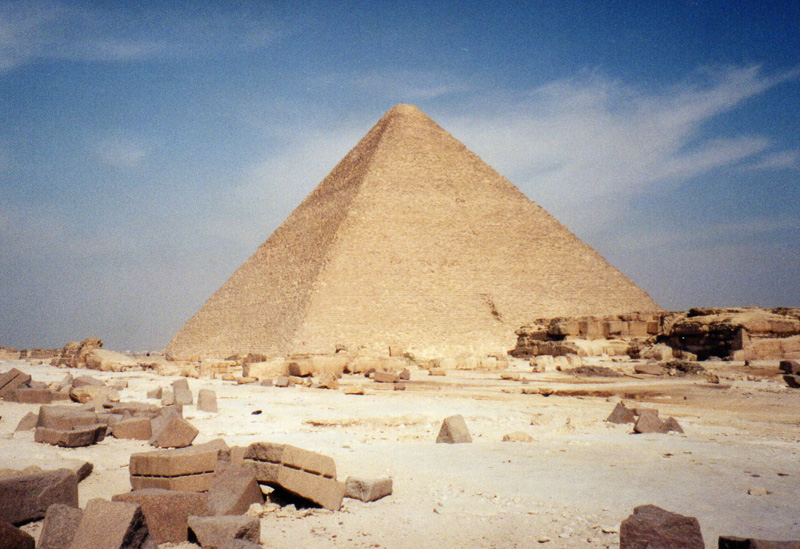



2589 BC - 2566 BC
Giza, Egypt
Khufu's Great Pyramid is the first and largest1 of the three major pyramids at Giza. Khufu is also known by the Greek name "Cheops." Khufu is the son of Snefru, who built the Bent Pyramid and the Red Pyramid (the first true pyramid) at Dashur. The architect of the Great Pyramid was Hemienu, a brother or half-brother of Khufu himself; Hemienu's tomb is sited on the Giza plateau, and a colossal statue of him is displayed in Hildesheim, Germany.
The pyramids were not built by armies of slaves. They were more like public works projects, with a force of perhaps 25,000 seasonal workers who were housed nearby for the two decades it took to build the Great Pyramid. During this time they had to quarry, transport, and assemble two million limestone blocks, averaging two and a half tons each, to build pharoah's "house of eternity." For more information, and the latest (as of 2009) theories about how all this might have been accomplished, see for example Bob Brier and Jean-Pierre Houdin, The Secret Of The Great Pyramid, Harper-Collins Publishers, 2008.
The earliest and greatest pyramids were tombs for kings; they were "resurrection machines," whose purpose was to ensure pharaoh's continuing life in the hereafter. Members of the royal family, and other nobles, might be favored with smaller pyramid tombs. Some kings built more than one pyramid, and some pyramids were be built for ritual purposes but were not intended to hold an actual burial.
The pyramids are not skyscrapers - the modern visitor may need a moment to adjust his frame of reference - but their size is, nevertheless, extremely impressive. For example, the great pyramid of Khufu covers an area of thirteen acres - much greater than the combined ground area of St. Peter's in Rome and St. Paul's in London, both of which it also exceeds in height. But such comparisons are, in a way, pointless. In the ancient world, there was nothing else to which the great pyramids could be compared. On a human scale, they were simply overwhelming.
The developed pyramid form, as seen at Giza, consists of four triangular sides, erected upon a square base, and meeting in a pyramidion (capstone) at the apex. The pyramid's core was constructed of granite blocks (Old Kingdom) or mud brick (Middle Kingdom), and faced with smooth white limestone. The pyramidion was covered in thin gold or electrum (an alloy of gold and silver). The whole construction would shine blindingly in the brilliant Egyptian daylight, in imitation of the rays of the sun itself, shining down from heaven.
To each pyramid there was associated a mortuary temple, in which rites were celebrated - sometimes for hundreds of years, or as long as the endowment lasted - to ensure the king's continued existence in the afterlife. The mortuary temple was attached to its pyramid by a causeway; earlier it faced north, towards the circumpolar stars, but later it faced east, towards the rising sun.
The historical development of Egyptian tombs comprised:
The multivalent symbolism of the Egyptian pyramids, in which one and the same icon carries multiple interpretations, is found in many non-Western cultures. But to the Egyptians, it was even more. Their deep belief in magic meant that the pyramids, to them, were not merely symbolic but physically effective: the pharaoh was actually reborn each morning from the mound of creation, actually crossed the sky each day with Re, and actually crossed the sky each night with the circumpolar stars.
It may seem odd that the deceased - and we are talking here about elite burials in general, not just the pharaohs - could, at the same time, be enjoying a conventional afterlife in their underground tomb-houses, hobnobbing with Osiris in the Fields of the Dead, swirling around the north pole on a cosmic journey, and sailing with Re on his solar barque. The Egyptians had an answer to this too. They divided the person into multiple aspects, that coexisted in life but separated in death to perform all these (and many other) functions: the Ba, the Ka, the Shadow, the Name, etc. Even more confusingly, these aspects could reunite in the afterlife - if one was truly blessed - to form a reintegrated personality known as an "effective akh," or as often translated, a "justified one." Every human culture needs some kind of story to reconcile the difference between the deceased (decaying) in his tomb and the deceased (immortal) in heaven, but Egypt took this farther than anyone - you could live forever in the earth, in your well-supplied tomb, and in heaven, and still be you.

|

|

|